What to Sell on Amazon 2025
Download Amazon Seller Guide
This guide will help you get started, understand the basics of Amazon selling, and explain in simple words how it all works.

As an Amazon seller, your primary goal is to find the winning products that are in high demand, have low competition, and are profitable. Looking for high-profit product opportunities for your Amazon store can be challenging, but it's essential to identify the ones that will give you a competitive edge.
In this post, we'll explore where to find the best Amazon products, highlight the best–selling categories, and explain how to research and select the right products for your Amazon business.
How to Look for Products to Sell on Amazon?
Finding the right products to sell on Amazon is a process that involves hunting for products and researching them to ensure success and avoid potential pitfalls. Below you can find a short description of the process of choosing Amazon products, which we will further discuss in detail.
Steps to looking for products to sell on Amazon
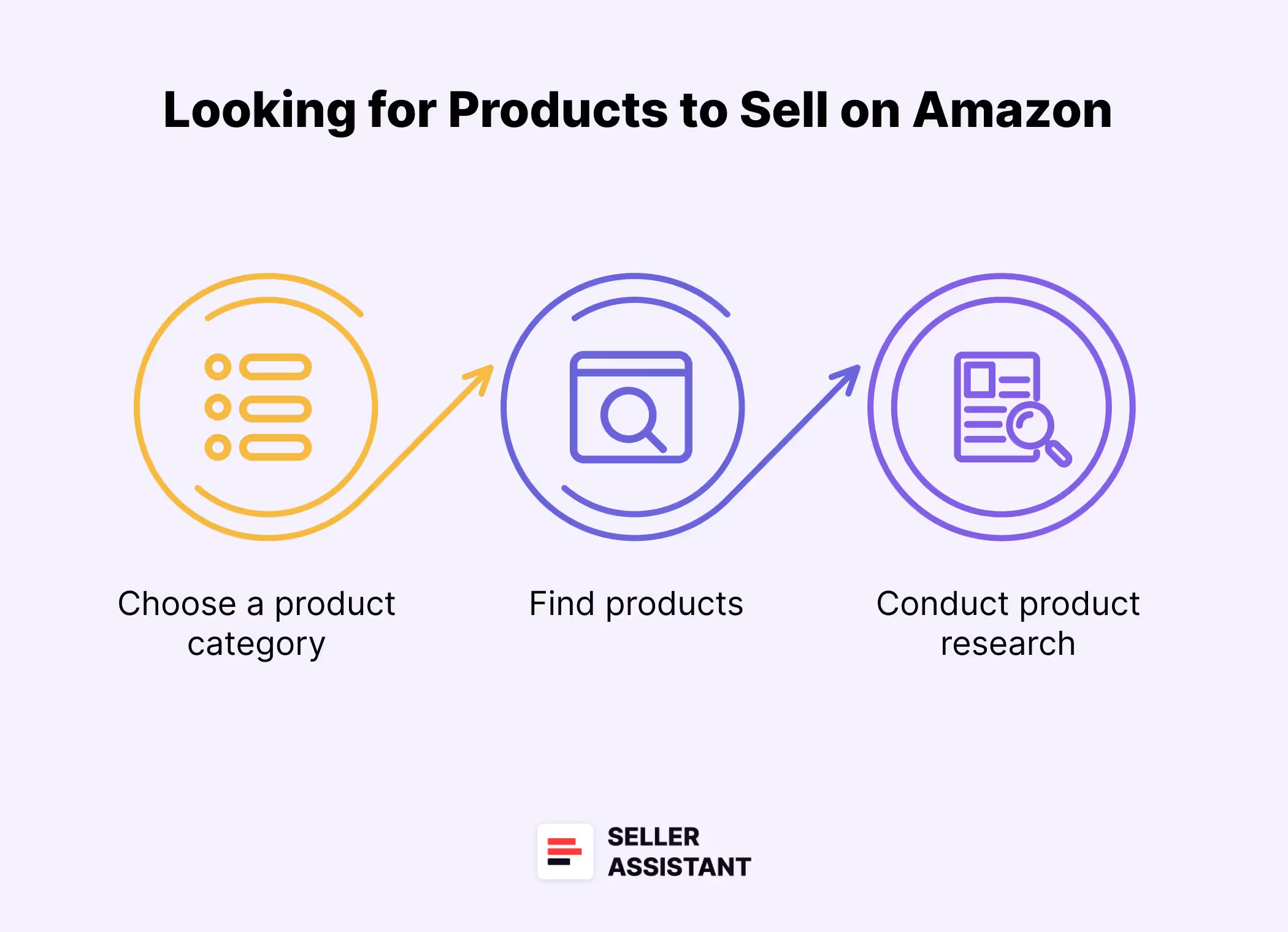
Related: Amazon FBA for Beginners
Seller Assistant Extension Review
Seller Assistant — the Ultimate Tool for Amazon Online Arbitrage
Step 1. Choose a product category
Start by selecting a product category that interests you and aligns with current market trends. Consider categories with consistent demand and growth potential, such as Home & Kitchen, Electronics, or Beauty & Personal Care.
Step 2. Find products
Once you've chosen a category, identify specific products within that niche. Look for items that solve common problems, cater to specific needs, or offer unique features. Amazon's Best Sellers, New Releases, and Movers & Shakers lists can provide valuable insights into best–selling products.
Step 3. Conduct product research
Thorough product research is crucial to ensure your chosen items will sell well and won't encounter any issues. Analyze the following aspects:
- Demand
Use tools like Seller Assistant to gauge the demand for your product. Look for items with steady sales volumes and positive trends.
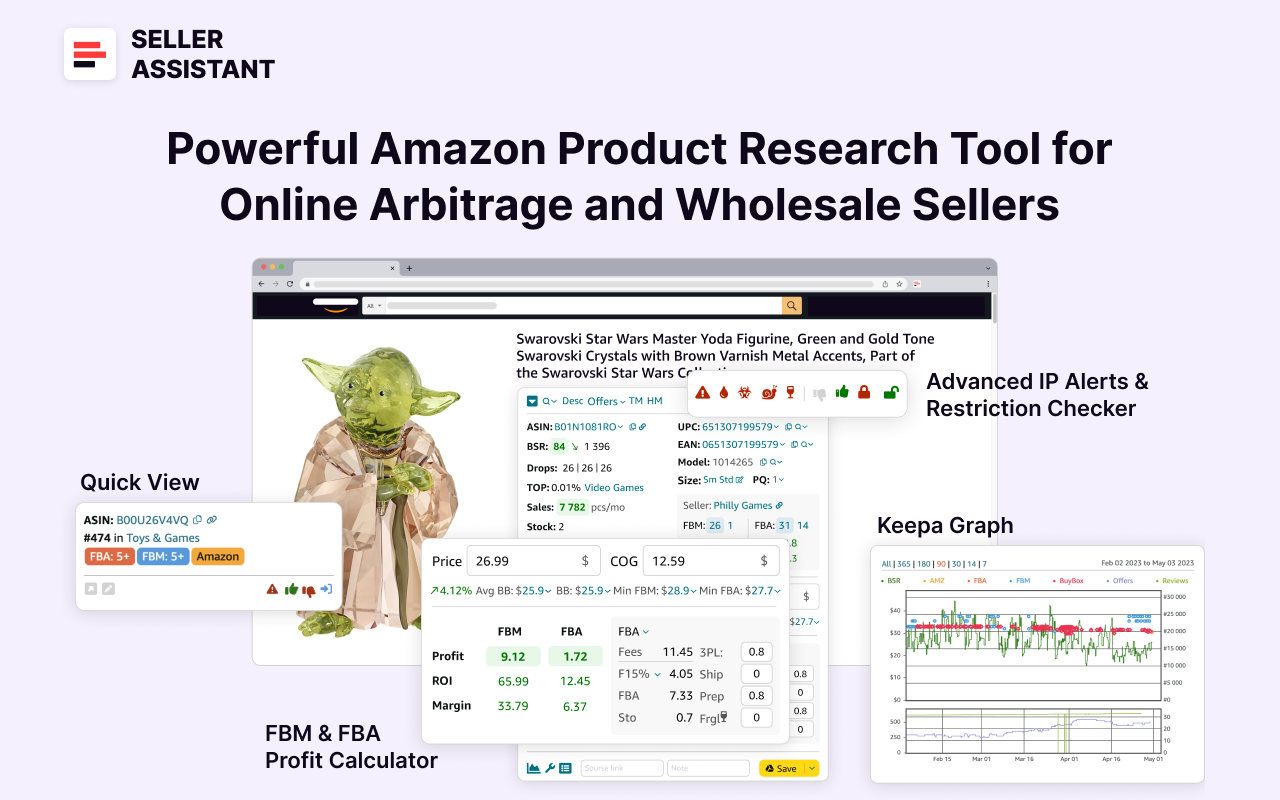
- Competition
Assess the level of competition by checking the number of sellers offering similar products. Aim for items with moderate competition to maximize your chances of standing out.
- Profit margins
Calculate the potential profit margins by considering product costs, Amazon fees, shipping expenses, and marketing costs. Ensure the product is financially viable.
- Selling eligibility and restrictions
Verify that you can sell products on your Amazon seller account. Check for potential issues such as restricted categories, or intellectual property issues, or flags like fragile, heavy and bulky, meltable, etc.
Note. Seller Assistant is a comprehensive product–sourcing software that helps Amazon sellers quickly find high–profit deals. It combines two extensions: Seller Assistant Browser Extension, and IP–Alert Chrome Extension by Seller Assistant, Amazon seller tools: Bulk Restrictions Checker and UPC/EAN to ASIN converter, and features: Side Panel View, FBM&FBA Profit Calculator, Quick View, Seller Spy, Stock Checker, IP Alert, and Restrictions Checker.
What Are the Best–Selling Amazon Categories?
When selecting products to sell on Amazon FBA, considering the product category is crucial. Certain categories are more popular among buyers due to various reasons.
Everyday items like electronics and clothing see consistent demand because people need and use them regularly. Other products, such as those in the home and kitchen categories, are favored because they enhance convenience and enjoyment in daily life.
However, it's also essential to consider the level of competition within each category. Categories like electronics and clothing tend to be highly competitive, whereas niche categories might have less competition but could also result in lower sales volumes.
According to Jungle Scout research, the following are the most popular categories among Amazon sellers, along with examples of best–selling products.
.avif)
Home & Kitchen (35%)
- Vitamix 5200 Blender: Known for its powerful motor and versatility.
- iRobot Roomba i7+: A robot vacuum with advanced cleaning features.
- Instant Pot Vortex 6–Quart Air Fryer: For healthier cooking options.
- OXO Good Grips 3–Piece Mixing Bowl Set: High–quality kitchen essentials.
- Lodge Cast Iron Skillet: Durable and perfect for various cooking needs.
Beauty & Personal Care (26%)
- L’Oréal Paris Voluminous Lash Paradise Mascara: A top–rated mascara.
- Neutrogena Hydro Boost Water Gel: A popular hydrating moisturizer.
- Philips Sonicare ProtectiveClean 6100 Rechargeable Electric Toothbrush: Advanced oral care.
- Revlon One–Step Hair Dryer and Volumizer: A favorite for quick styling.
- Burt’s Bees 100% Natural Origin Moisturizing Lip Balm: A must–have for lip care.
Clothing, Shoes & Jewelry (20%)
- Under Armour Men's Charged Assert 9 Running Shoe: Popular for comfort and support.
- The North Face Women's Resolve 2 Jacket: A reliable outdoor jacket.
- Calvin Klein Men’s Boxer Briefs: Essential everyday wear.
- Ray–Ban RB2132 New Wayfarer Sunglasses: Iconic and stylish eyewear.
- Fossil Women's Jacqueline Stainless Steel Casual Quartz Watch: A classic timepiece.
Toys & Games (18%)
- NERF Elite 2.0 Commander RD–6 Blaster: A top choice for kids and adults.
- Melissa & Doug Wooden Building Blocks Set: A timeless educational toy.
- Nintendo Switch – OLED Model: Popular for gaming enthusiasts.
- Crayola Inspiration Art Case Coloring Set: Great for budding artists.
- Hot Wheels Monster Trucks Stunt Tire Play Set: Exciting for car lovers.
Health, Household & Baby Care (17%)
- Philips Norelco OneBlade Hybrid Electric Trimmer and Shaver: A versatile grooming tool.
- Purell Advanced Hand Sanitizer Gel: Essential for hygiene.
- Arm & Hammer Pure Baking Soda: A staple for cleaning and baking.
- Thermometer for Adults, Infrared Forehead Thermometer: Useful for health monitoring.
- Cottonelle Ultra ComfortCare Toilet Paper: A household necessity.
Baby (16%)
- Graco Pack 'n Play Portable Playard: Ideal for travel and home use.
- Tommee Tippee Closer to Nature Baby Bottles: Favored by many parents.
- Skip Hop Baby Activity Center: Keeps babies entertained and stimulated.
- Owlet Smart Sock 3 Baby Monitor: Offers peace of mind for parents.
- BabyBjörn Bouncer Balance Soft: Comfortable and practical for infants.
Electronics (16%)
- Amazon Echo Dot (5th Gen): Popular smart speaker with Alexa.
- Apple MacBook Air (M2, 2024): Favored for its performance and portability.
- GoPro HERO11 Black: A top choice for adventure enthusiasts.
- Bose QuietComfort 45 Wireless Headphones: Known for excellent sound quality.
- Fitbit Charge 5: A leading fitness tracker.
Sports & Outdoors (16%)
- Garmin Forerunner 245 Music: A favorite among runners.
- YETI Tundra 45 Cooler: Perfect for camping and outdoor activities.
- Theragun Elite Handheld Percussive Massage Device: Popular for muscle recovery.
- The North Face Borealis Backpack: Versatile for hiking and daily use.
- Schwinn Discover Hybrid Bike: Ideal for commuting and leisure rides.
Books (14%)
- “The Light We Carry” by Michelle Obama: Inspirational and thought–provoking.
- “Atomic Habits” by James Clear: A guide to building good habits.
- “Project Hail Mary” by Andy Weir: A thrilling science fiction novel.
- “The Four Winds” by Kristin Hannah: A gripping historical fiction.
- “The Silent Patient” by Alex Michaelides: A best–selling psychological thriller.
Where to Find Products for Amazon?
Amazon is a vast marketplace with millions of products, making it challenging to find the right items to sell. Here are some effective methods to discover profitable products with good demand and high search rankings on Amazon.
10 ways to find product ideas for Amazon
- Competitor analysis
Analyzing your competitors can provide valuable insights into successful products and market gaps you can exploit. Use Seller Assistant's Seller Spy to monitor competitor activity, track new and discontinued products, and understand pricing strategies. This information can help you identify products to add to your inventory.

Add your competitors to Seller Spy, and it will provide you with the report where you can see which brands and products your competitors add and how they price them. You can add the same products to your store.
- Supplier price list research
Supplier price lists often contain thousands of potential products. To quickly identify profitable items, use Seller Assistant's Price List Analyzer. This tool processes supplier lists and highlights high–margin products, providing metrics like ROI, BSR, Buy Box price, and Amazon fees.

You can upload your supplier price list to Price List Analyzer, then download a report with ROI, BSR, Buy Box price, and Amazon fees, and filter the products by any metric to find profitable deals.
- Scrape and spot product ideas
Online arbitrage sellers or dropshippers without existing suppliers, can scrape product data from e–commerce websites and analyze it with Seller Assistant's Price List Analyzer. This helps identify profitable opportunities for resale on Amazon.
- Amazon Best Sellers
The Amazon Best Sellers list showcases the most popular products on the platform. It's a great resource for finding high–demand items.
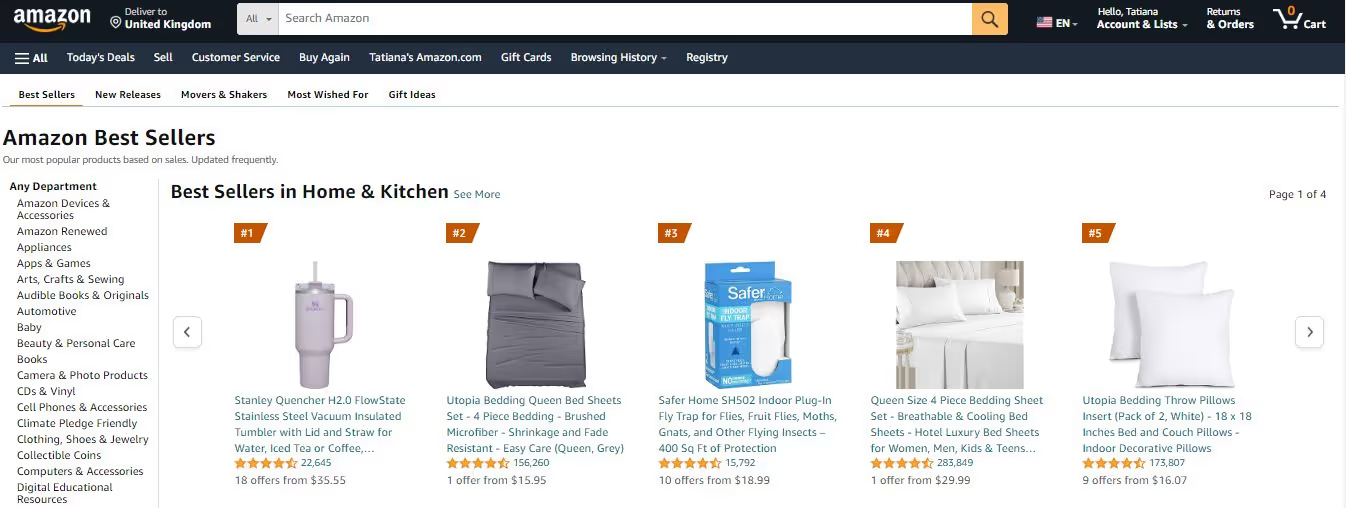
- Amazon Movers & Shakers
The Movers & Shakers list highlights products with the biggest sales increases in the last 24 hours. This is a useful tool for identifying trending products.
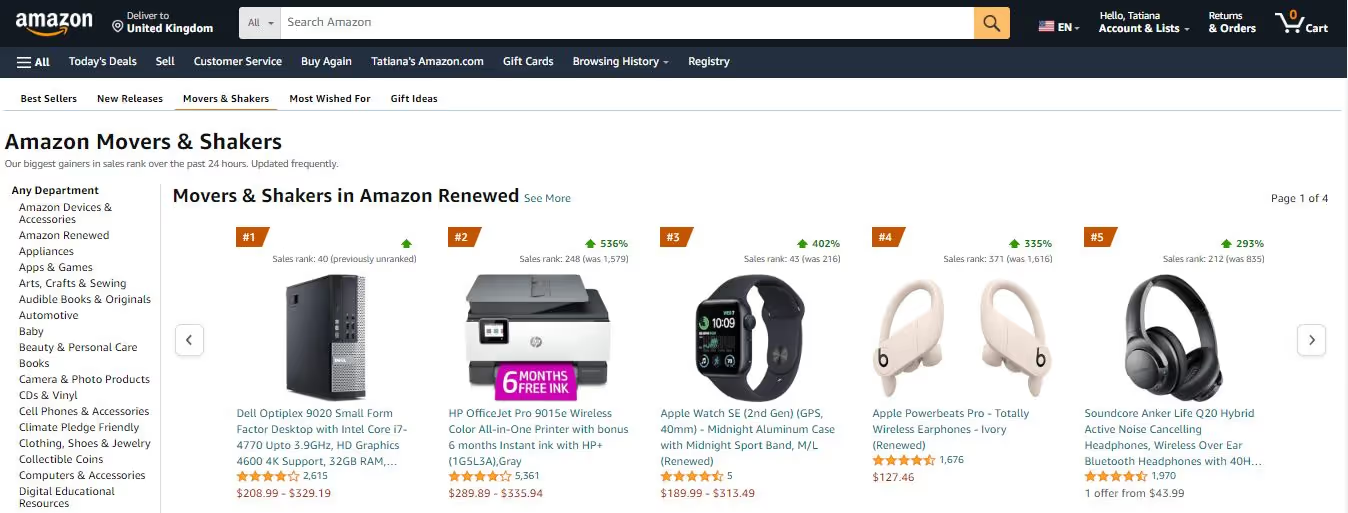
- Amazon’s Hot New Releases
Hot New Releases shows the newest products added to Amazon, providing insights into new and innovative items that could be profitable.
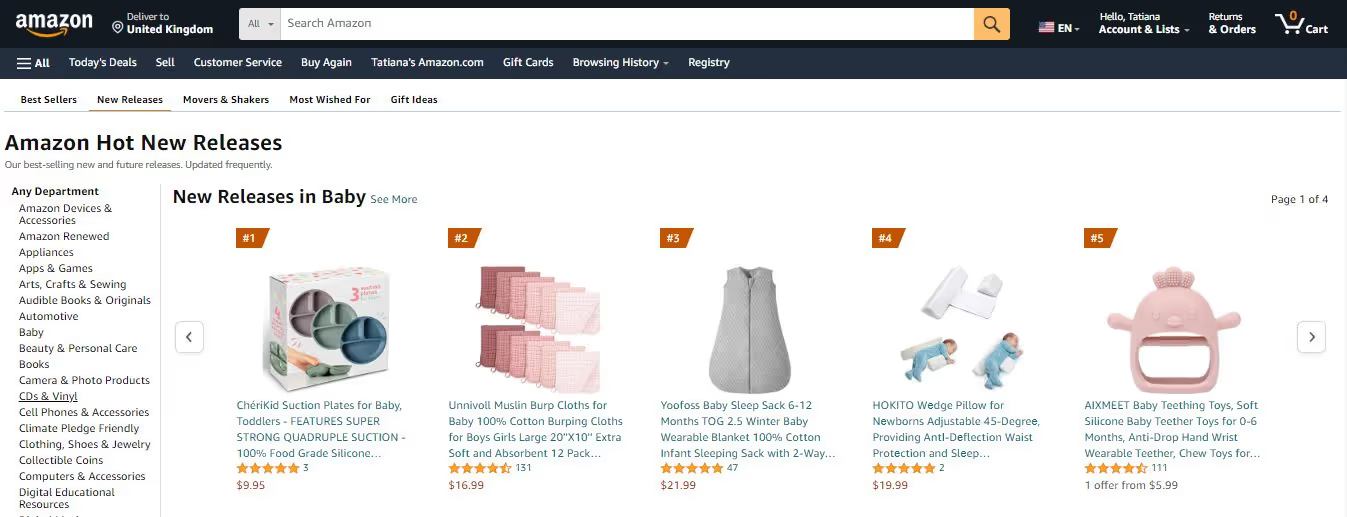
- Amazon "Most Wished For" List
The Most Wished For list displays products frequently added to wishlists, indicating strong customer interest and potential future purchases.
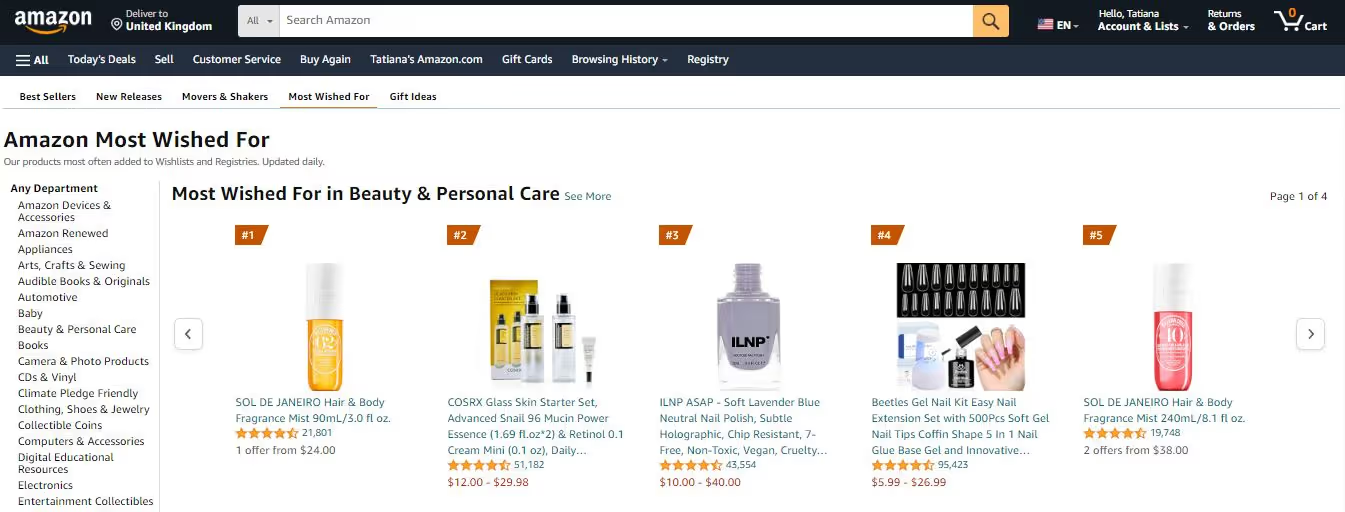
- Amazon Trends
Amazon trend posts highlight rising products and categories. Review these posts for insights into trending items and find similar products for your store.

- Social media and online communities
Social media platforms, forums, and community groups can offer insights into current interests. Follow relevant hashtags on Instagram, join Facebook groups related to your niche, and participate in Reddit forums to gather ideas and feedback.
- Google Trends
Google Trends lets you track product popularity over time, helping you identify rising trends. Search for product–related keywords with high search volumes and analyze their patterns. Be mindful of seasonal trends that may affect product sales.
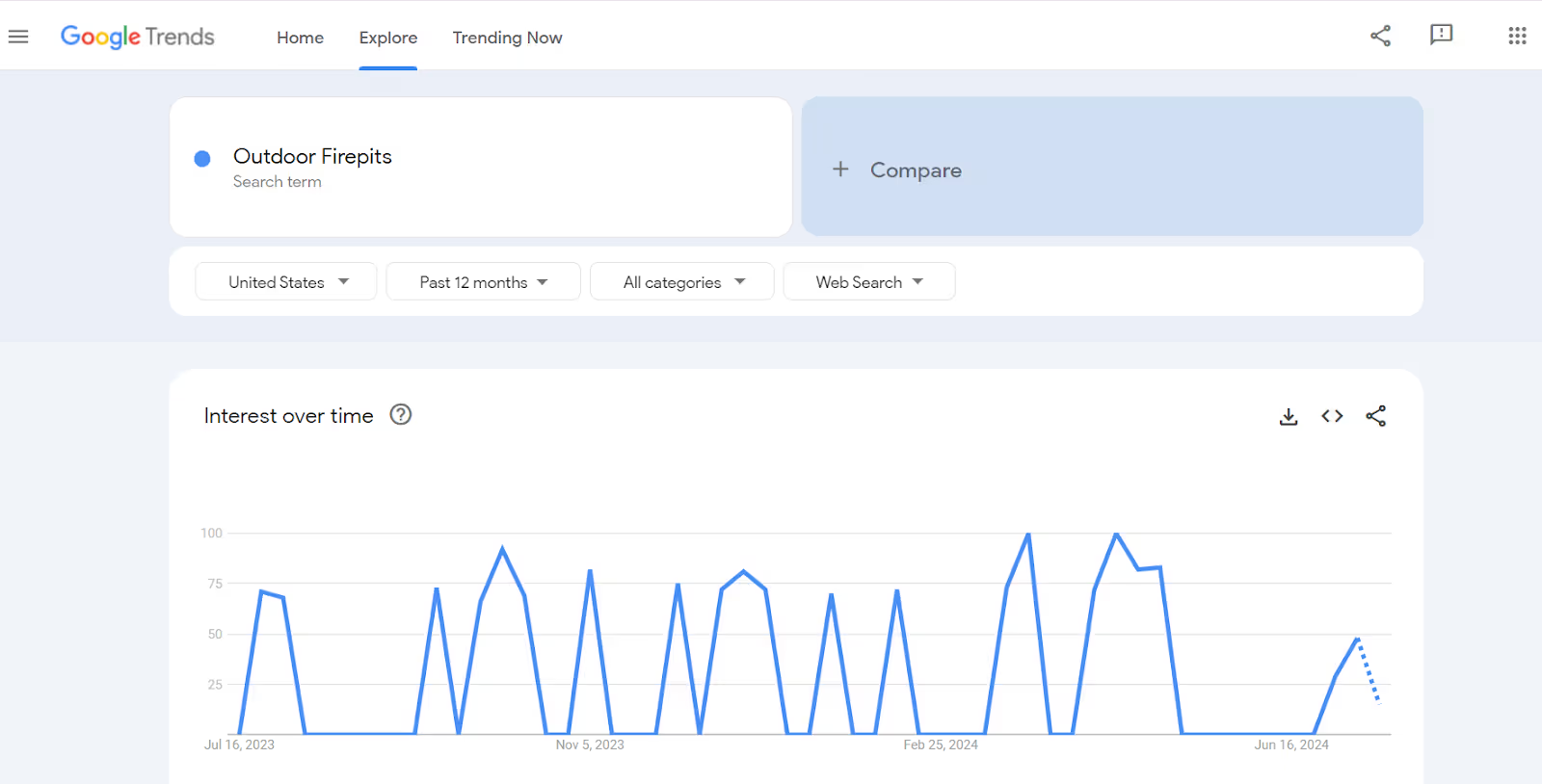
What Are the New Product Trends in 2025?
Some products are gaining popularity in 2025, and you can monetize this. However, when reselling trendy products, exercise caution due to the high level of competition and the rapidly changing nature of trends. Investing heavily in these items can be risky unless the trend is proven and sustainable.
Here are five trendy product types for 2025, with a short description and examples for each, along with explanations for their popularity.

Smart home devices
Smart home devices are electronic gadgets designed to automate and enhance the functionality of a home, making it more efficient and convenient.
Examples
- Smart thermostats (e.g., Nest Learning Thermostat) – These devices learn user preferences and adjust the temperature automatically to save energy and increase comfort.
- Smart speakers (e.g., Amazon Echo, Google Nest) – Equipped with virtual assistants, these speakers can control other smart devices, play music, and provide information.
- Smart doorbells (e.g., Ring Video Doorbell) – They offer video surveillance and two–way communication, enhancing home security.
- Smart lighting (e.g., Philips Hue) – These lights can be controlled remotely, change colors, and be scheduled to create the perfect ambiance.
- Robot vacuums (e.g., iRobot Roomba) – They autonomously clean floors, making household chores easier.
Why trendy
The increasing integration of technology in daily life, the convenience of automation, and the push towards energy efficiency make smart home devices highly desirable. Additionally, advancements in AI and IoT (Internet of Things) contribute to their functionality and appeal.
Health and wellness products
Products in this category are designed to promote physical and mental well-being.
Examples
- Fitness trackers (e.g., Fitbit, Apple Watch) – These wearables track physical activity, heart rate, and sleep patterns.
- Smart water bottles (e.g., HidrateSpark) – They track water intake and remind users to stay hydrated.
- Massage guns (e.g., Theragun) – These devices provide deep muscle treatment to relieve soreness and improve recovery.
- Air purifiers (e.g., Dyson Pure Cool) – They clean the air of pollutants and allergens, enhancing indoor air quality.
- Blue light glasses (e.g., Felix Gray) – Designed to reduce eye strain from screens, these glasses filter out blue light.
Why trendy
The growing awareness of health and fitness, and the boom of remote work (increasing screen time) drive demand for these products. Consumers are increasingly investing in their well-being and seeking ways to enhance their health routines.
Tech gadgets
Innovative and cutting-edge devices that offer new functionalities and enhance user experiences.
Examples
- Foldable smartphones (e.g., Samsung Galaxy Z Fold) – These phones feature flexible screens that can fold, providing a larger display in a compact form.
- Wearable health devices (e.g., Oura Ring) – These wearables track a range of health metrics, from sleep to heart rate variability.
- Portable Projectors (e.g., Anker Nebula Capsule) – Compact and easy to set up, they allow for big–screen viewing anywhere.
- Wireless earbuds (e.g., Apple AirPods Pro) – Offering high–quality sound and convenience, they are popular for music and calls.
- VR headsets (e.g., Oculus Quest 2) – Virtual reality devices that provide immersive gaming and entertainment experiences.
Why trendy
Continuous advancements in technology, increasing consumer interest in innovative gadgets, and the integration of tech into everyday life drive the popularity of tech gadgets. Their ability to offer new experiences and improve convenience makes them highly sought after.
Wearable technology
Wearable technology refers to electronic devices that can be worn on the body, often designed to track health and fitness metrics or enhance connectivity.
Examples
- Smartwatches (e.g., Apple Watch, Samsung Galaxy Watch) – Track fitness, health metrics, and notifications, integrating seamlessly with smartphones.
- Fitness bands (e.g., Fitbit Charge, Garmin Vivosmart) – Focus on activity tracking, heart rate monitoring, and sleep analysis.
- Smart rings (e.g., Oura Ring) – Compact devices that monitor health metrics like sleep, activity, and recovery.
- Augmented reality glasses (e.g., Google Glass, Vuzix Blade) – Overlay digital information onto the real world, useful for various professional and recreational applications.
- Hearables (e.g., Jabra Elite, Bose SoundSport) – Wireless earbuds with fitness tracking capabilities, noise cancellation, and voice assistant integration.
Why trendy
The trend towards health consciousness, the need for constant connectivity, and advancements in miniaturization and sensor technology drive the popularity of wearable tech. Consumers are increasingly interested in real–time health data and seamless integration with other digital devices.
Gaming accessories
Gaming accessories are peripherals and enhancements designed to improve the gaming experience.
Examples
- Gaming headsets (e.g., SteelSeries Arctis, Razer Kraken) – Offer high–quality sound, comfortable wear, and often include microphones for communication.
- Mechanical keyboards (e.g., Corsair K95, Razer BlackWidow) – Provide tactile feedback and durability, preferred by gamers for precision and speed.
- Gaming chairs (e.g., Secretlab Omega, DXRacer) – Ergonomically designed for long gaming sessions, offering support and comfort.
- Custom controllers (e.g., SCUF, Xbox Elite Wireless Controller) – Offer customizable buttons, triggers, and ergonomic designs to enhance gameplay.
- VR gaming systems (e.g., Oculus Rift, PlayStation VR) – Provide immersive gaming experiences through virtual reality technology.
Why trendy
The growing popularity of esports, the increase in home entertainment, and the continuous advancements in gaming technology contribute to the demand for high-quality gaming accessories. Gamers seek enhanced performance, comfort, and immersive experiences, driving the market for these products.
How to Choose Products to Sell on Amazon?
Once you have product ideas for your Amazon store, ensure their viability by researching factors such as competition, demand, and profitability. Product sourcing tools can assist in this process.
The ideal product sourcing tool for selecting high-profit items for your Amazon store is Seller Assistant. It helps you identify profitable deals directly on Amazon product and search pages, while also enabling comprehensive research on supplier websites.
Below are some tips on how to choose products that will be profitable and avoid issues when selling them.
Steps to research Amazon FBA Products with Seller Assistant
Step 1. Remove the referral from the product link
- Action
Delete the referral part of the link (starting with ref=). To do it, click the ASIN in Seller Assistant.

- Purpose
This ensures you receive accurate information about the product.
Step 2. Assess Product Sales Potential
- Action
Use the Sales field in Seller Assistant to estimate product sales based on BSR (Best Sellers Rank).
- Indicators
- Average BSR
Look at the average BSR over 90 days and observe the trend (upwards or downwards).
- Trend arrows
Green arrow down indicates increasing sales; red arrow up indicates decreasing sales.
- BSR drops
Shows the number of times BSR is recalculated downward, indicating actual product sales over 30, 90, and 180 days.
- Top percentage
Indicates the product’s sales velocity. A Top of 0.5% or less means the product sells well; 1% or more means it's a slow-mover.
- Sales
A calculation showing how many products you can potentially sell based on BSR.
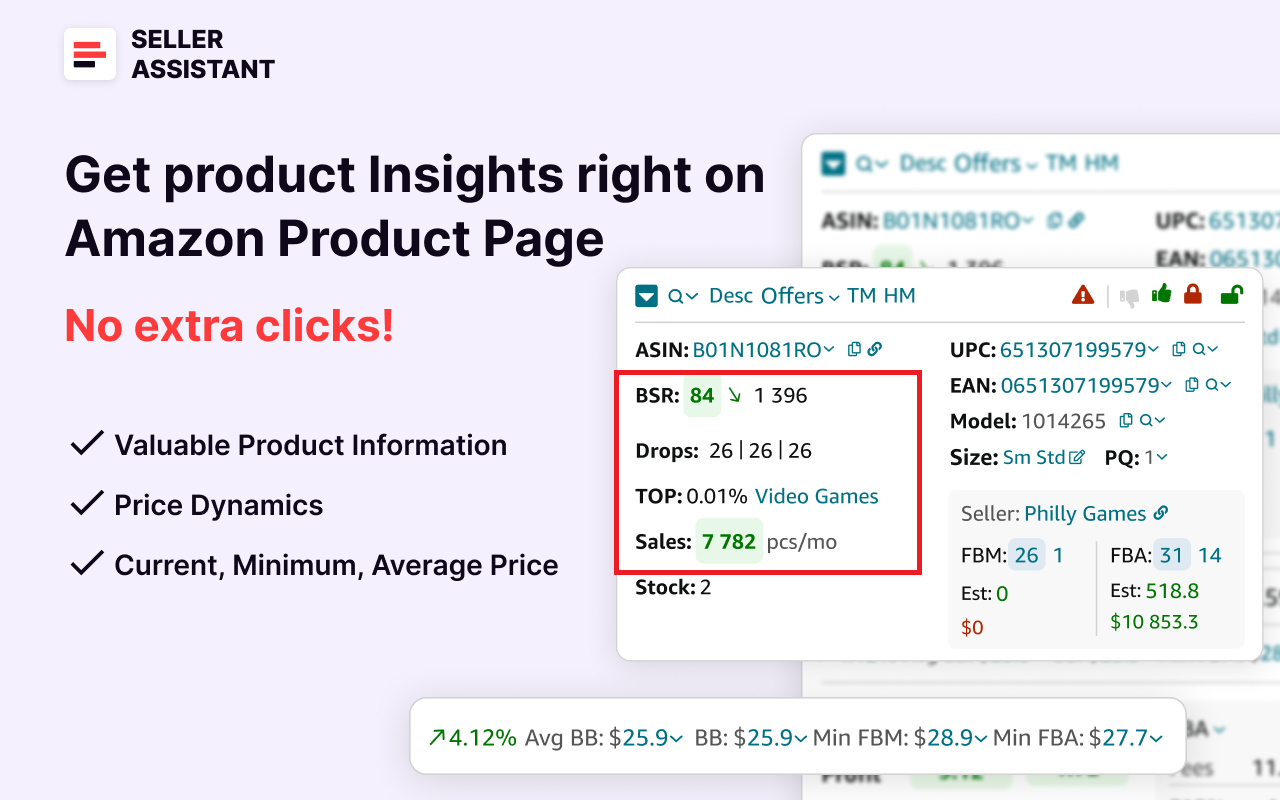
Step 3. Assess competition by fba seller count
- Action
Check the number of FBA sellers.
- Recommended count
2 to 15 FBA seller offers.
- Tool
Seller Assistant displays FBA and FBM seller counts on product and search pages.
- Indicator
The number on a blue background shows all FBA or FBM sellers; the number on a white background shows sellers offering the Buy Box price +5%.

Step 4. Check if Amazon is a seller
- Action
Look for the red Amazon icon on product and search pages.
- Indicator
If Amazon is a Buy Box seller, Seller Assistant will alert you with this icon.
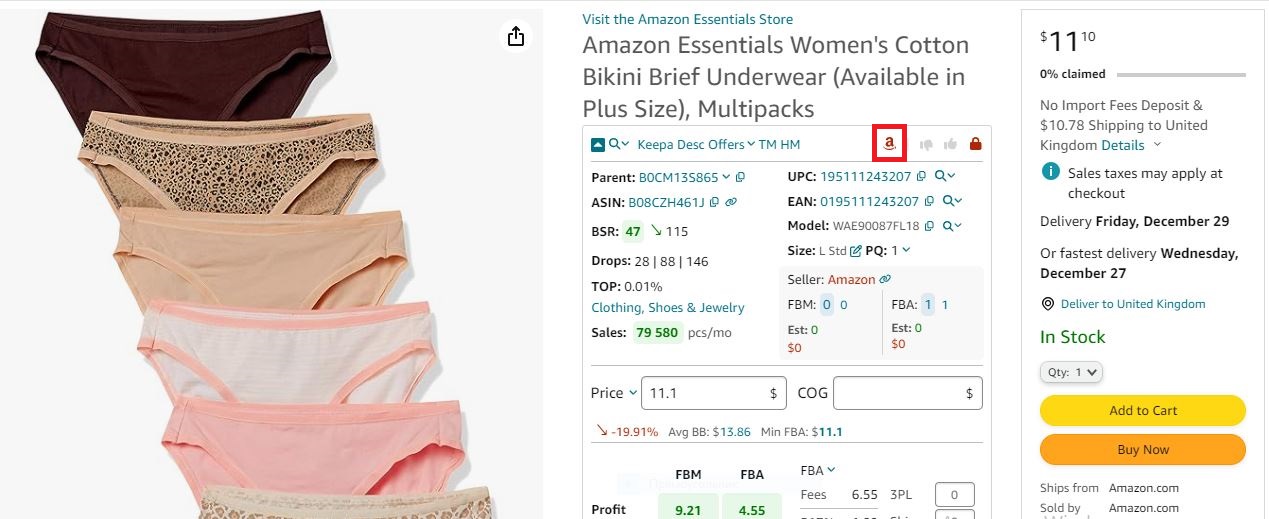
Step 5. Review listing history
- Action
Verify that the product listing is at least six months old.
- Tool
Use the Keepa chart integrated within Seller Assistant.
- Purpose
Ensure there is sufficient data to understand sales history. New products will lack this data.

Step 6. Determine the product’s selling price
- Action
Check the average Buy Box price (Avg BB), lowest FBA (Min FBA), and lowest FBM (Min FBM) prices.
- Indicators
Use these prices to calculate product profitability.

Step 7. Identify if you can win the Buy Box
- Action
Use Seller Assistant to see the Buy Box percentage per seller.
- Purpose
Understanding if there is a dominating seller in the Buy Box (Featured Offer) helps in strategizing to win it.
- Indicators
Seller Assistant shows the Buy Box share by seller on the Offers feature. Analyze if any competitor dominates the share or if you can beat their price.

Step 8. Identify how much you can sell
- Action
Apply Seller Assistant to estimate the number of units you can sell.
- Indicators
Seller Assistant will show you the estimated potential sales figures if you become one more seller on the listing.

Step 9. Identify best-selling variations
- Action
Use Seller Assistant’s Variation Viewer.
- Indicators
Look for variations with the highest rating percentage and total ratings. Select the most profitable variation based on these metrics.
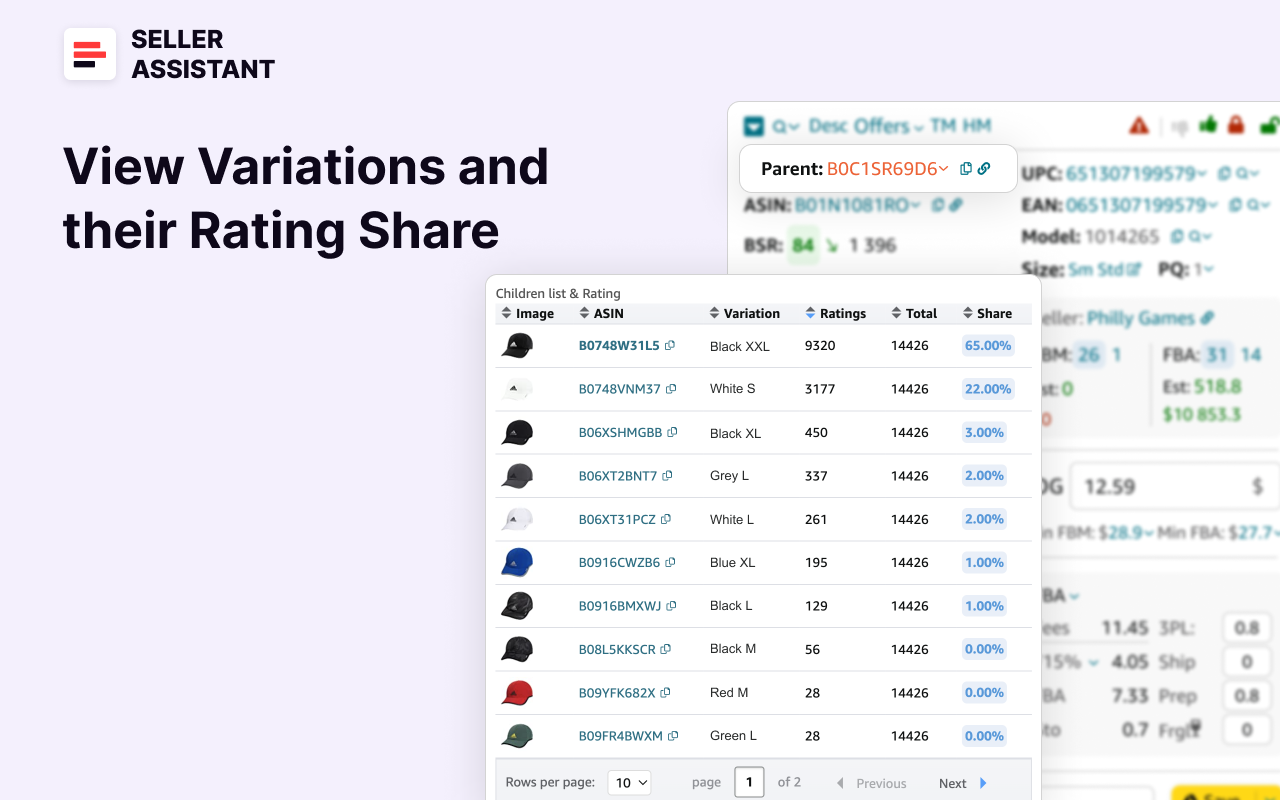
Step 10. Research product reviews
- Action
Check the product's review data via the Keepa chart in Seller Assistant.
- Indicators
A successful product typically has a 4-5 star rating. Minimal negative reviews are preferable.
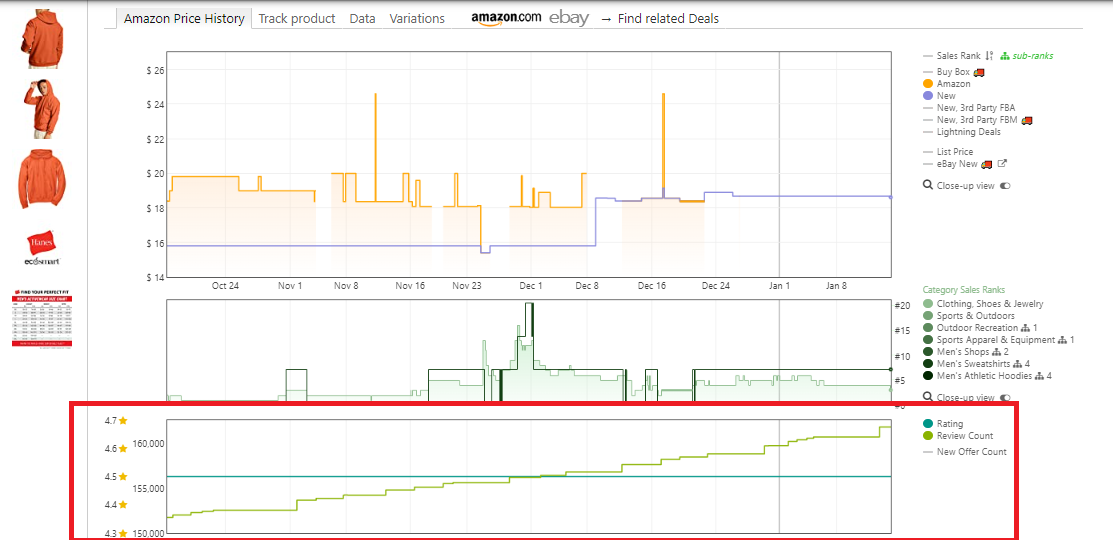
Step 11. Confirm selling eligibility
- Action
Check Seller Assistant for eligibility status.
- Indicators
- Green open lock means you can sell the product.
- Red closed lock means a product is restricted and you cannot sell the product without Amazon’s approval.
- Red closed lock with an exclamation mark means you can’t sell a product on your account.

Step 12. Avoid products with IP Complaints
- Action
Check for products restricted on Amazon or those with intellectual property (IP) issues.
- Tool
Use Seller Assistant’s IP Alert extension.
- Indicators
IP Alerts: Items with IP alerts are marked with a red triangle, indicating potential issues with intellectual property complaints.

Step 13. Check product for flags and alerts
- Action
Look for flags on the Amazon product pages.
- Indicators
Heavy and bulky, fragile, meltable, hazardous materials, adult products, generic brands, and other flags.

Step 14. Calculate product profitability
- Action
Use Seller Assistant’s FBM&FBA profit calculator.
- Target
Aim for a Return on Investment (ROI) above 20%.
- Calculation
Enter Cost of Goods Sold (COG, price at the supplier), and logistics costs to get Profit, ROI, Margin, and FBA or FBM fees.
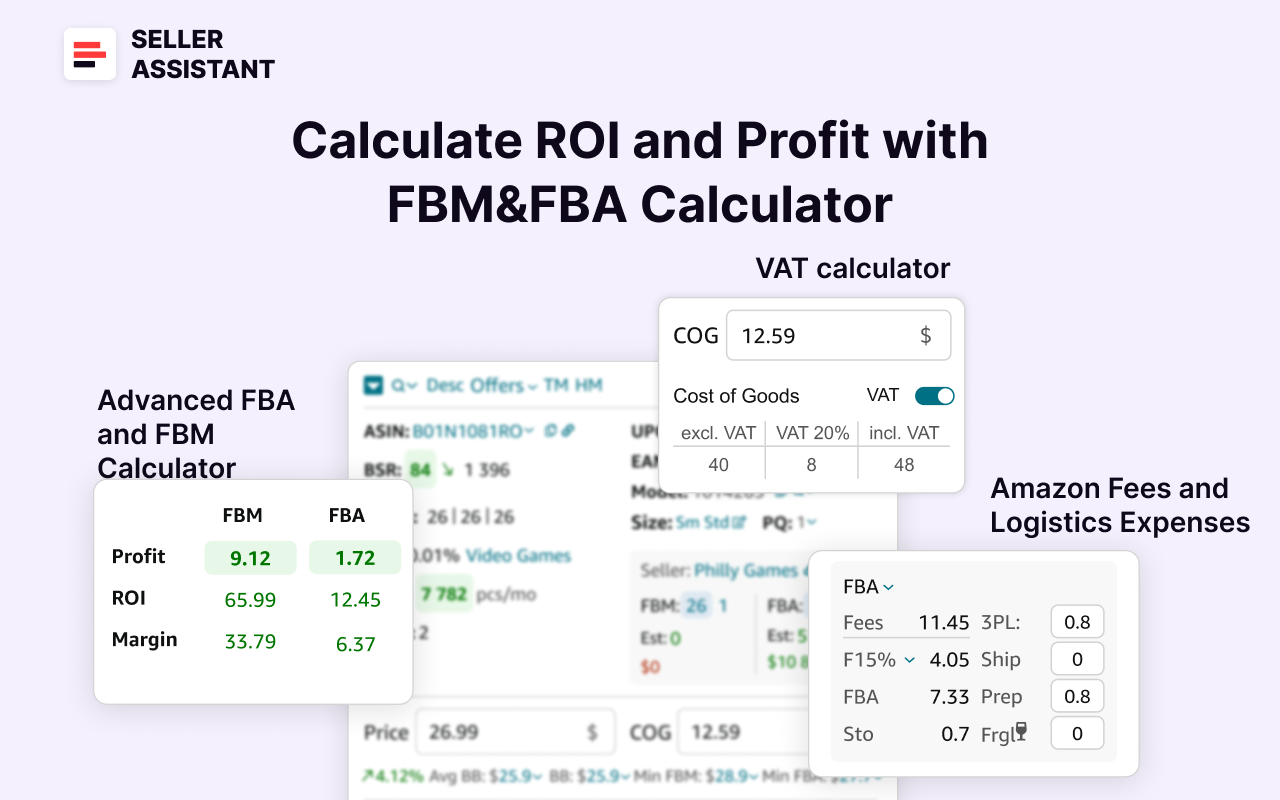
FAQ
Is it profitable to sell on Amazon?
Yes, selling on Amazon can be profitable due to the platform's vast customer base and advanced seller tools, which can enhance visibility and sales potential. However, it requires careful product selection, competitive pricing, and effective product research to succeed in a highly competitive environment.
What is needed to sell with Amazon?
To sell on Amazon, you need to create a seller account and list your products with accurate product research and pricing to make sure you get a profit. Additionally, it's essential to comply with Amazon's policies and guidelines, and manage inventory.
Is it free to be an Amazon seller?
No, it is not free to be an Amazon seller; there are costs involved such as a monthly subscription fee for professional sellers and various selling fees that depend on the category and type of product sold. Individual sellers pay a fee per item sold instead of a subscription fee
How can I make money selling with Amazon?
You can make money selling on Amazon by selecting high-demand, profitable products and using product sourcing software like Seller Assistant to find such products. Additionally, leveraging Amazon's fulfillment services (FBA) can help deliver products to customers (the service is paid).
Can you be an individual Amazon seller?
Yes, you can be an individual Amazon seller without needing a professional account. Individual sellers pay a fee per item sold rather than a monthly subscription fee, making it a cost-effective option for those selling less than 40 items/month.
What are the Amazon Individual and Professional selling plans?
Amazon offers two selling plans: the Individual plan, where sellers pay $0.99 per item sold and is suited for those selling fewer than 40 items a month; and the Professional plan, which costs $39.99 per month regardless of the number of items sold and includes additional tools and benefits for high-volume sellers. Both plans also incur referral fees and variable closing fees based on the product category.
Is Fulfillment by Amazon (FBA) worth it?
Yes, Fulfillment by Amazon (FBA) is worth it for many sellers as it provides efficient inventory management, shipping, and customer service, enhancing the shopping experience and potentially increasing sales. However, it involves additional fees and costs, which should be carefully considered to ensure profitability.
Final Thoughts
To succeed with selling on Amazon, selecting the right products is essential. The detailed guidance in this post helps you to identify products that are in high demand, have lower competition, and offer good profitability.
Before launching a product, thorough research is critical. Evaluate the factors discussed in this post, including demand, competition, profitability, and any product restrictions and alerts, to make informed decisions.
Seller Assistant helps you identify profitable products among thousands of potential deals on Amazon. It also assists in quickly and reliably doing advanced product research.
Seller Assistant is a new-generation product sourcing software offering all the features you need to find the most profitable products to sell on Amazon. It includes Seller Spy, Side Panel View, FBM&FBA Profit Calculator, Quick View, ASIN Grabber, UPC/EAN to ASIN converter, Stock Checker, IP Alert, and Restrictions Checker, and other key product research features and provides value for money.
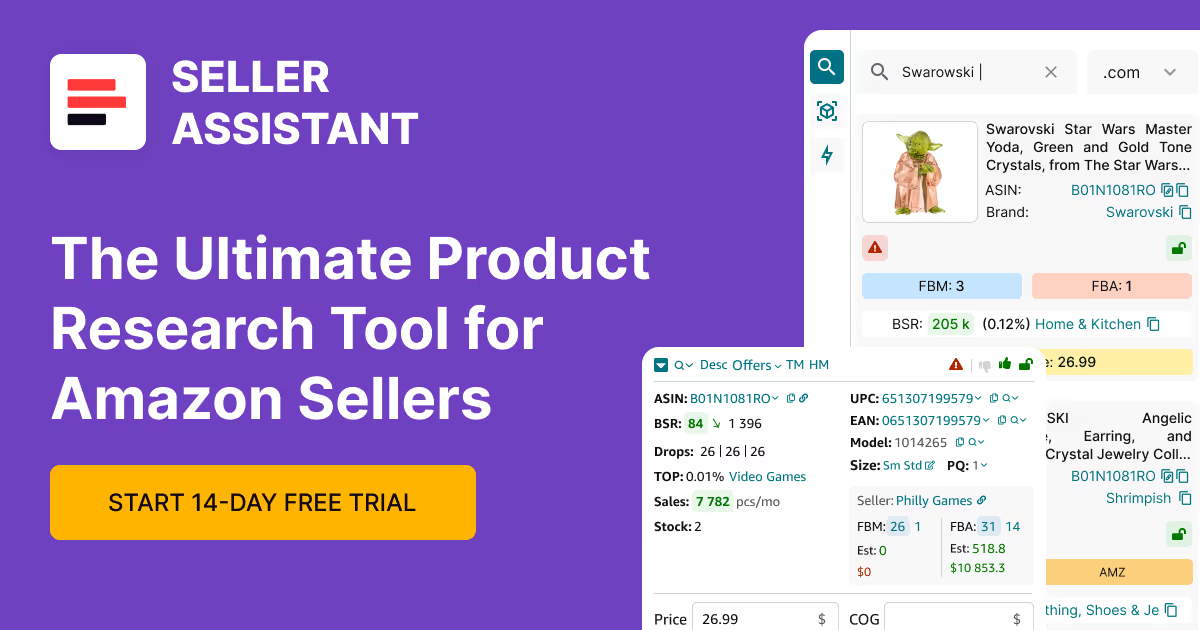
.svg)













